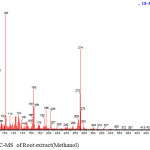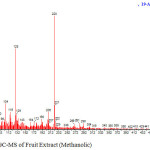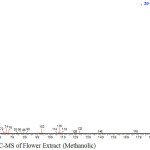Pharmacological Studies of Root, Fruit and Flower of Berberis lycium
1Department of Chemistry, Uttaranchal University, Dehradun, Uttarkhand, 248007, India.
2Department of Chemistry, UCALS, Uttaranchal University, Dehradun, Uttarkhand, 248007, India.
Corresponding Author E-mail: ajay21singh@yahoo.com
DOI : http://dx.doi.org/10.13005/ojc/340257
Article Received on : January 18, 2018
Article Accepted on : March 02, 2018
Herbal plants have many bioactive compounds in their different parts which are responsible for biological activities in the body like antimicrobial, antioxidant, anti-inflammatory properties etc. Berberis lycium is one of the most rare herbal plant found in the Garhwal region of Uttarakhand. In the present work different extracts of fruit , roots and flowers of Berberis lycium belonging to the family of Berberidaceae were studied and compound were identified. antimicrobial and antioxidant activities were determined. The study revealed the presence of some biologically active components like, 3-Benzyl-1,2-dihydronaphthalene, N-(4-Biphenylyl)benzamide, N-Phenylbenzanilide- etc were detected in flower, fruit and root extract after GC-MS analysis. Methanolic extracts have shown good antimicrobial potential which can be used in in medicines after further study in future.
KEYWORDS:Antimicrobial Activity; Extract; Berberidaceae; Antioxidants
Download this article as:| Copy the following to cite this article: Gupta M, Singh A. Pharmacological Studies of Root, Fruit and Flower of Berberis lycium. Orient J Chem 2018;34(2). |
| Copy the following to cite this URL: Gupta M, Singh A. Pharmacological Studies of Root, Fruit and Flower of Berberis lycium. Orient J Chem 2018;34(2). Available from: http://www.orientjchem.org/?p=44738 |
Introduction
Plant kingdoms are the rich source of organic compounds, many of which have been used for medicinal purposes. In traditional medicine, there are many natural crude drugs that have the potential to treat many disease and disorders.1-2
The Himalaya and its region is rich in terms of herbal plants. Uttarakhand, which includes the major divisions of Kumaun and Garhwal, is a part of Indian Himalayan region and hence is endowed with rich biodiversity. As medicinal plants receive increased scientific and commercial attention, there is increasing pressure on the wild plant populations from which most of the medicinal plants are harvested. Overharvesting of these medicinal plants have led some of the species to become endangered3-4.
Berberis lycium is an evergreen, erect shrub belonging to the family Berberidaceae. The genus Berberis comprises of as many as 500 species. Out of which 77 species are native to India 5. Berberis lycium grows upto a height of 3m, with a thick woody shoot and covered with a thin brittle bark. Berberis lycium has bright yellow color flowers, which are hermaphrodite in nature; i.e. both male and female organs are present on the same flower. It is pollinated by insects. The fruits are bluish purple in color on ripening. The fruit is slightly acidic and juicy in nature. The plant possesses wide ecological amplitude and seeds can be grown in sandy, silty or loamy soils6.
In this study fruit and flower extracts in addition to root extracts, were taken for detection of bioactive compound and pharmacological activity due to them.
Material and Methods
Collection of samples
The roots, fruits and flowers were collected from Garhwal region of Uttarakhand during summer season of May to July and preserved in the advanced chemistry lab of Uttaranchal University, Dehradun.
Extract Preparation
The roots, fruits and flowers were collected separately and were washed thoroughly with running tap water and finally with distilled water. After shade drying for 10-15 days the roots were crushed into powdered form with the help of mortar and pestle. Then it was added to soxhlet assembly for extraction using water, methanol and n-hexane. It was heated for about 6 hours at a temperature less than the boiling point of the solvent. The extract was further concentrated by rotary evaporator, residue was stored for further process where as in case of aqueous media same amount of sample was dissolved in water and boiled, filtered and saved for further process 7.
Collection of Bacterial strains
Total 12 microbial cultures belonging to 8 bacterial species and 4 fungi were used in this study. The identified microorganisms were obtained from Microbiology laboratory, Uttaranchal University, Dehradun.
Antimicrobial activity and Antioxidant activity
The root, fruit and flower extracts of Berberis lycium prepared above were again dissolved in similar methanol, n-hexane and water (100mg/ml) and sterilized. The antimicrobial activity test was carried out by disk diffusion by using 50μl of suspension spread on potato dextrose agar (PDA), Mueller hinton agar (MHA) media respectively. The disks (6mm) containing 10μl of extracts (300μg/disk) with the concentration of 100mg/ml were impregnated in the inoculated agar. Negative control was prepared by using similar solvents of plant extracts. The inoculated plates were incubated at 37°C for 24 hours in the case of clinical bacteria strains, 72 hours for fungi isolate. First, inhibitory activity was tested in different solvent extracts of root, flower and fruits. Solvent extracts which have shown positive antimicrobial activity were taken for detailed zone of inhibition by disc diffusion method. Antimicrobial activity was assessed by measuring inhibition zones in reference to test organisms and each process was repeated to get more precise results. Antioxidant Activity of the selected plant extracts were measured by the Enzymatic Antioxidant and Non- Enzymatic Antioxidants methods. The enzymatic antioxidant properties were determined by superoxide dis-mutase (SOD), and Non Enzymatic Antioxidant property was determined in the form of vitamin C.i.e ascorbic acid and beta-carotene bleaching method8-9.
Observations
The results observed are presented in the form of tables are given below. Antimicrobial effect have been measured in terms of zone of inhibition (mm), which is given in table -1 and antifungal effect have been shown in table-2.
Table 1: Zone of inhibition (diameter in mm) shown by extracts of berberis lycium against selected bacterial strains.
| Microorganisms (Bacteria) | RootAqueous | RootMethanol | Rootn-hexane | FruitMethanol | Fruit Aqueous | Fruitn-hexane | Flower Aqueous | Flower Methanol | Flowern-hexane |
| Escherichia coli (Gram Negative) | ND | ND | ND | ND | ND | ND | 13 | 13 | ND |
| Pseudomonas aeruginosa(Gram Negative) | 14 |
13 |
11 | 14 |
16 |
16 |
17 | 20 | 18 |
| Salmonella typhi (Gram Negative) | 16 | 17 | 15 | ND | ND | ND | ND | 17 | ND |
| Proteus mirabilis (Gram negative) | ND | ND | ND | 12 | 12 | 13 | 13 | 17 | 14 |
| Acinetobacter baumannii (Gram negative) | ND | 16 | ND | ND | 13 | ND | 20 | 12 | ND |
| Staphylococcus aureus (Gram positive) | 12 | ND | ND | ND | 14 | ND | 14 | 19 | ND |
| Enterococcus (Gram positive) | ND | ND | ND | ND | 15 | 16 | 16 | 28 | 18 |
| Klebsiella pneumoniae (Gram negative) | ND | 14 | 13 | 13 | 13 | 12 | 12 | 15 | 14 |
ND-Not detected
Table 2: Zone of inhibition (diameter in mm) shown by extracts of berberis lycium against selected fungal strains.
| Microorganisms (fungi) | Root Aqueous | Root Methanol | Rootn-hexane | Fruit Methanol | Fruit Aqueous | Fruitn-hexane | Flower Aqueous | Flower Methanol | Flowern-hexane |
| A.cuboida | ND | ND | ND | ND | ND | ND | ND | 16 | ND |
| A.niger | ND | ND | ND | 13 | 15 | 12 | ND | 14 | ND |
| A.fumigatus | ND | 12 | 10 | ND | ND | ND | ND | 14 | 13 |
| Candida albicans | ND | 11 | 8 | ND | ND | ND | ND | ND | ND |
Table 3: Enzymatic Antioxidant Acitivity (SOD)
| Part used | Solvent extract | SOD ( unit/mg of protein) |
| Roots | Aqueous | 18.5 |
| Roots | methanol | 10.2 |
| Roots | n-hexane | 19.7 |
| Fruit | Aqueous | 20.1 |
| Fruit | methanol | 21.0 |
| Fruit | n-hexane | 18.9 |
| Flower | Aqueous | 16.0 |
| Flower | methanol | 15.8 |
| Flower | n-hexane | 15.2 |
Table 4: Antioxidant activities of extract with DPPH assay
| Plant Part | Solvent extract | DPPH Inhibition % |
| Root | Aqueous | 72 |
| Root | Methanol | 62 |
| Root | n-hexane | 78 |
| Fruit | Aqueous | 65 |
| Fruit | Methanol | 55 |
| Fruit | n-hexane | 70 |
| Flower | Aqueous | 56 |
| Flower | Methanol | 48 |
| Flower | n-hexane | 68 |
Table 5: Estimation of non – enzymatic Antioxidant(Vitamin C )
| Plant Part | Solvent extract | Vitamin C |
| Root | Aqueous | 1.4 mg / g |
| Root | Methanol | 1.2 mg /g |
| Root | n-hexane | 1.7 mg / g |
| Fruit | Aqueous | 2.5 mg/g |
| Fruit | Methanol | 1.4 mg / g |
| Fruit | n-hexane | 1.2 mg /g |
| Flower | Aqueous | 1.9 mg / g |
| Flower | Methanol | 1.1 mg / g |
| Flower | n-hexane | 1.2 mg /g |
 |
Figure 1: GC-MS of Root extract(Methanol) |
Table 6: Compounds identified in GC-MS analysis ( Root Extract)
|
S. No |
Compound name | Molecular weight | Molecular Formula |
|
1. |
N-(4-Biphenylyl)benzamide | 273 | C19H15ON |
| 2. | N-Phenylbenzanilide | 273 |
C19H15ON |
 |
Figure 2: GC-MS of Fruit Extract (Methanolic) Click here to View figure |
Table 7: Compounds identified in GC-MS analysis ( Fruit Extract)
| S.No | Compound name | Molecular weight | Molecular Formula |
| 1. | 3-Benzyl-1,2-dihydronaphthalene | 220 | C17H16 |
 |
Figure 3: GC-MS of Flower Extract (Methanolic) |
Table 8: Compounds identified by GC-MS Analysis (Flower extract)
| S.No | Compound Name | Molecular weight | Molecular Formula |
| 1. | Dihydro-2-methyl-3(2H)-thiophenone | 116 | C5H8OS |
| 2. | 1-ethenylsulfanylbutane | 116 | C6H12S |
Result and Discussion
It is evident that the inhibitory activity was exhibited by the components present in Berberis lycium and not by the solvents used for extraction. From table-1, it is clear that methanolic and aqueous extracts of flower followed by fruit and then followed by root have shown antimicrobial potential against selected stains. Flower extract is most potent against most of the selected bacterial stains. Alcoholic extract of flower have shown maximum 28mm zone of inhibition against bacteria Enterococcus (Gram positive) followed by Pseudomonas aeruginosa (Gram Negative) . In n-hexane extract it was found mostlv potent against Pseudomonas aeruginosa and Enterococcus of 18mm.
Aqueous extract of root have shown sensitivity against salmonella followed by Pseudomonas, similar trend of result was obtained by Ursoon Khan for anti-microbial effect of root extract of berberis lycium10. Methanolic extract have shown maximum anti-microbial effect against salmonella (Gram negative) followed by Acinetobacter baumannii and Klebsiella pneumoniae. Alcoholic extract was not found effective against Staphylococcus aureus and E.coli.8 reported that root extract not effective against Staphylococcus aureus , Escherichia coli and Klebsiella. Those results are almost similar for root extract with the finding in this study.
Aqueous fruit extract is effective against most of the bacteria selected and found to be most effective against Pseudomonas aeruginosa (Gram Negative) with 16 mm zone of inhibition followed by 15 mm against Enterococcus (Gram positive). In this study it was observed that aqueous extract of fruit of berberis lycIum is more potent than alcoholic fruit extract.
Flower extracts have shown antimicrobial effect against almost all bacterial strains, its flower extract was observed to be most effective against Acinetobacter baumannii (20 mm) followed by Pseudomonas aeruginosa (17 mm) and 16 mm against Enterococcus. Alcoholic extract of flower has shown maximum anti-microbial effect against Enterococcus (28 mm) followed by Pseudomonas aeruginosa which is higher than shown by standard antibiotic(ciprofloxacin)11. also studied antibacterial activity of root extract of this plant and results are almost in similar trend11. It can also be concluded that methanol is better solvent for antimicrobial activity of root extract similar to findings obtained by7. Overall in this study we observed strong antibacterial potential in flower extract followed by fruit and root extract. It was observed that the results of antibiotic properties almost in the similar trend12. It was found in their studied that berberine is main compound which is responsible for biological activity12-13.
From table 2 it is observed that flower extract is most potent extract against all the selected fungal strains while root extract was observed to be least effective. Alcoholic extract (flower) when tested against the fungal strains exhibited maximum inhibitory zone against a.cuboida followed by A. niger and A. fumigatus while Aqueous extract (flower) was observed to be almost ineffective. Fruit extract was observed to be effective against A.niger.
In this study investigating the in vitro antimicrobial activity, the results showed that the methanolic extract of flowers and fruit extract (methanolic extract) from Berberis lycium possessed maximum antibacterial property in comparison to other extract which showed some or no activity, confirming the great potential of bioactive compounds .
Antioxidant activity has shown the presence of some antioxidant like vitamin C. Vitamin C is found to be highest in aqueous fruit extract 2.5mg/g then followed by aqueous flower extract 1.9mg/g showing the potential for future use. As shown in the table 5. In table 3. showed the presence of enzymatic antioxidant was 20.1 in aqueous fruit extract while 21.0 (unit/mg of protein) in methanolic fruit extract. 19.7 was found in n-hexane root extract.
Highest percentage of DPPH was found in n-hexane root extract followed by aqueous root extract that was 72 as shown in the table 4.
Further when GC-MS of root, fruit and flower extract was done in which some bioactive compounds were identified. From table 6 it was observed that these compounds were identified as N-(4-Biphenylyl)benzamide, N-Phenylbenzanilide. GC-MS analysis of methanolic fruit extract as shown in the table 7 one compound was identified as 3-Benzyl-1,2-dihydronaphthalene . GC-MS flower methanolic extract showed the presence of Dihydro-2-methyl-3(2H)-thiophenone, 1-ethenylsulfanylbutane as shown in the table 8.
Conclusion
This means that some components are present in the root, fruit and flower of Berberis lycium that are responsible for the inhibitory activity of some of the bacterial and fungal strains. In vivo data may be helpful in determining the real potential usefulness of this plant for the treatment of infectious diseases. The medicinal plants have shown to have safety and efficacy in pharmacological activities including as antifungal activity.
The results showed that the flower, fruit and root extracts from Berberis lycium possessed good antimicrobial and antioxidant activity, confirming the great potential of bioactive compounds and are useful for rationalizing the use of this plant in primary health care. In vivo data may be helpful in determining the real potential of flower, fruit and root extracts of this plant.
References
- Anwar AK., Ashfaq M. and Nasveen MA. (1979): Pharmacognostic studies of selected indigenous plants of Pakistan, (Peshawar, NWFP, and Pakistan: Pakistan Forest Institute).
- Sharma Manik, Iqbal Javaid, Kailash Som, Asgher Mohd, Younis Mohd, Tripathi Jagrati, Shezad Fakhar and Hura Ud Din Mera. Multi-therapeutic activity of Berberis lycium royle: A ReviewInternational Journal of Advanced Research. 2016.4(12),2419-2431.
- Roberson Emily Medicinal Plants at risk: A native Plant conservation campaign report.
- Gupta Mansi and Singh Ajay. Antimicrobial activity of extract of Berberis lycium. University journal of phytochemistry and ayurvedic heights.2016,1(20),51-54.
- Iqbal Ahmad and Arina Z. Beg.Antimicrobial and phytochemical studies on 45 Indian medicinal plants against multi-drug resistant human pathogens.Journal of Ethnopharmacology.2001,74.113-123.
- Ahmed Sajjad, Shauib Muhammad, Ali Kashif, Ali Sajjad and Hussain Fida. Evaluation of different parts of Berberis lycium and their biological activities: a review. Pure Appl. Bio.2017,6(3),897-907.
- Chandra G.V, Purohit M,1980 Medicinal plants of India. ICMR, New Delhi, pp 377.
- Husain T, Rao R.R and Garg A.1998. Feddes Repertorium.
- Shinwari Zabta Khan Sarwat and Ahmad Nisar.Screening of potential medicinal plants from district sawat specific for controlling women diseases. Pak.J.Bot.2012,44(4),1193-1198.
- Sharma R, 2003. Medicinal Plants of India, an Encylcopedia, Delhi, Daya Publishing House.
- Khan Uroosa and Fatima Aziz. In vitro evaluation of antibacterial activity of Berberis lycium against clinical isolates.Journal of biological research and applied sciences.2016,7(2).
- Irshad A.H, Pervaiz A.H, Abrar Y.B, Fahelboum I, Z.S Bahlul. Awen. Antibacterial activity of Berberis lycium root extract. Trakia Journal of Sciences.2013, No.1,88-90.
- Gupta Mansi, Singh Ajay, Joshi Chandra Harish. Berberis lycium multipotential medicinal application: An overview. International Journal of Chemical Studies.2015. 3(4), 10-13.

This work is licensed under a Creative Commons Attribution 4.0 International License.










